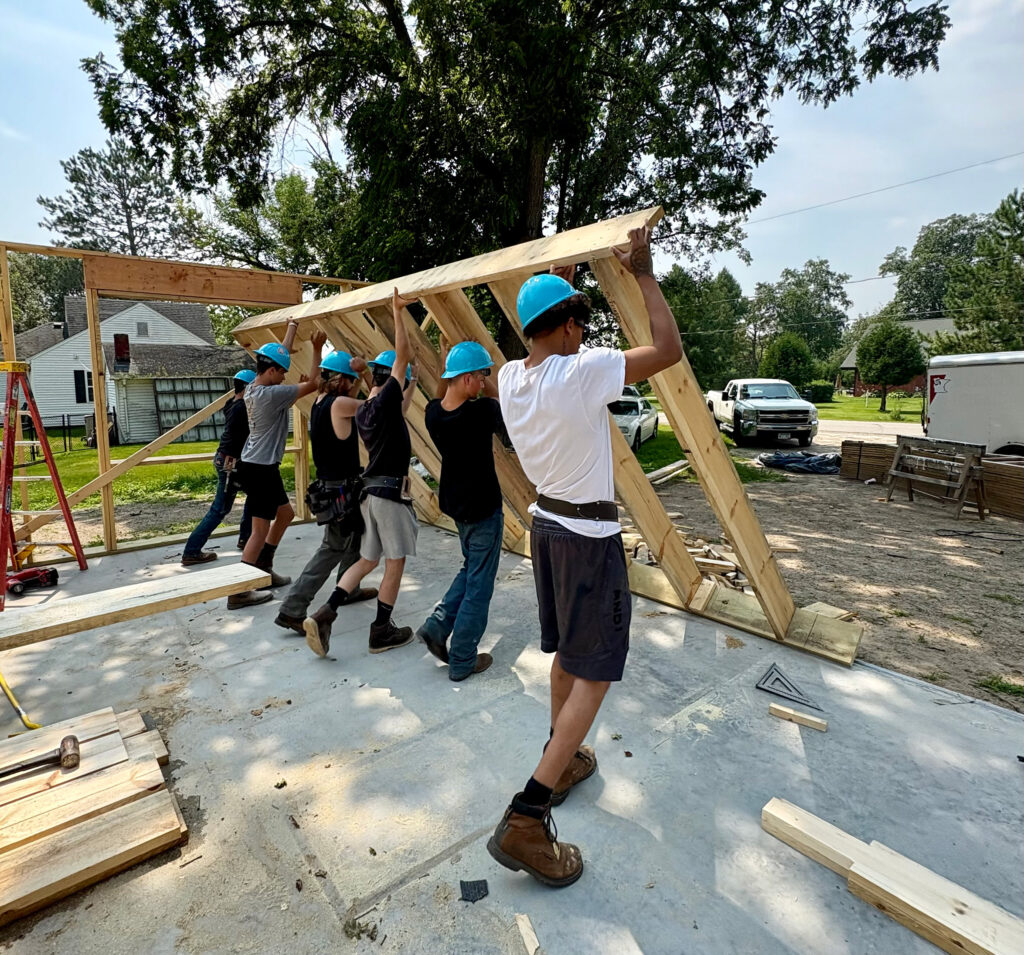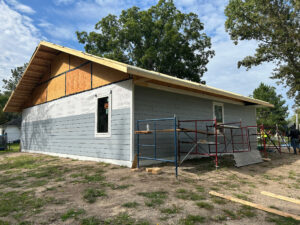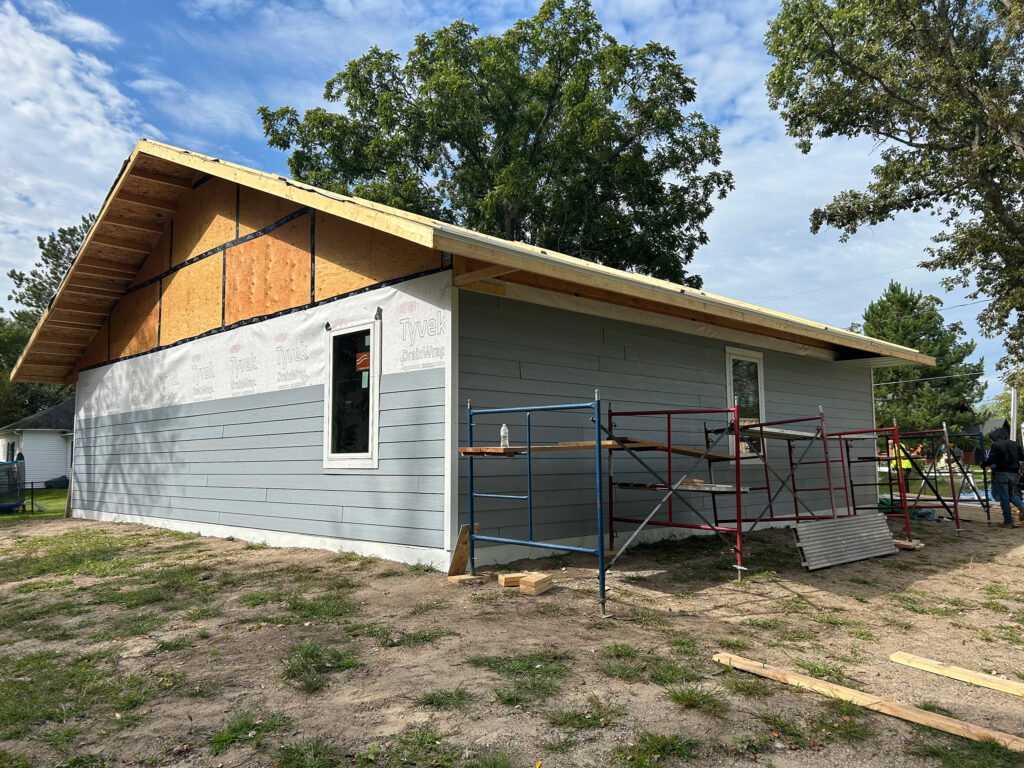 Image: Blog hero Plant Plate 09 boys dig in
Image: Blog hero Plant Plate 09 boys dig in
Doing More, Building More, Helping More

by Blandin Foundation Posted in Grants, Rural Capacity Building
Itasca County Habitat for Humanity is tackling the area’s housing crisis with help from a capacity building grant.
In Blandin Foundation’s home giving area of Itasca County, the ongoing need for affordable housing is great. Most lenders generally agree that households should spend no more than 30 percent of their monthly income on their mortgage — less, if possible — in order to comfortably afford other living expenses. In Itasca County, 66 percent of homeowners and 34 percent of renters put more than 30 percent toward their mortgage and rent, according to a Minnesota Compass study released last year.
Since 1992, Itasca County Habitat for Humanity has been building and providing affordable homes for community members in need. Their New Home Program gives families earning lower incomes stability while helping them grow their economic assets through home ownership. But the high demand for homes, combined with the organization’s small staff and limited capacity, had Executive Director Jamie Mjolsness looking for solutions.
“We wear so many different hats. I couldn’t grow. I couldn’t do more,” Jamie shared. “It was keeping us stagnant, building one to maybe two houses a year at the most.”

Two houses a year may sound like a lot. However, a 2024 study by the Itasca County Housing and Redevelopment Authority identified a five-year demand of anywhere from 95 to 105 new single family homes, or 19 to 21 per year.* Jamie realized that what she needed most was an additional staff member to help take a load off of her plate. Much of her week was spent with Habitat families one on one, an important and fulfilling role, but one that was pulling her away from other projects that could help Itasca Habitat do more, build more, help more.
“A lot of people don’t realize that Habitat is also ‘The Bank,’” Jamie explained. “We have to have qualified loan originator training, and we’re writing mortgages. There’s a lot of legalities that go into it. [Working with families] was taking up so much of my time that I couldn’t necessarily work as vastly on the fund development side. I thought if I could take away the largest part of what I work on, I could do more with fund development.”
Itasca Habitat had applied for and received funding from Blandin Foundation in previous years. “They’ve supported us probably almost since our inception,” Jamie joked. (She’s right — the first grant awarded to Itasca Habitat came in 1993.) Since then, Blandin has regularly supported the team’s work with operating support grants and funds for home construction. After the foundation shifted its strategic direction in 2021 to both realign its work with current rural challenges and founder Charles Blandin’s original vision, Jamie met with Kyle Erickson, Blandin Foundation’s director of rural grantmaking, to talk through her team’s capacity building needs and her unique idea of putting grant funding toward the hiring of a new family support manager. Itasca Habitat received $100,000 in 2023 to help make the role a reality.
“I understood why they changed their [strategic] direction and how they could support nonprofits in growth vs. just in sustaining,” Jamie said. “I love the fact that now they’re kind of getting us to think a little bit more outside of the box.”
Enter Amanda MacDonell, who previously worked with the Itasca County Housing and Redevelopment Authority and had also served for two years on Itasca Habitat’s board of directors.
“It was during my time on the board that this new position was being brainstormed,” Amanda said. “As a board, you do some strategic planning and thinking about the needs of the organization, and you hear this across the board: capacity is the number one thing that’s lacking in organizations. So it made sense for Jamie to try to make that move to expand her staff.”
The timing was ideal, as Amanda had decided to retire from the HRA but wasn’t quite ready for true retirement. After years working for a public government authority, she missed working with residents and other community members one on one: sharing a prayer with them, having in-person conversations with them, and getting to know them on a personal level.
“It just wasn’t something that I could do in that type of field,” she shared. “After being retired for a little bit, knowing that I couldn’t sit still for long, I decided I was going to just throw my hat into the ring for the job. I feel like everything that I have ever done in my career, from the time I was working at a soda fountain in Detroit Lakes to everything that I’ve done in the meantime professionally, has honed me for this position.”
With Amanda onboarded, Jamie was able to dive head first into fund development, something she’d been wanting to do more of for years. She pursued and received funding from Minnesota’s Iron Range Resources and Rehabilitation agency that has allowed Itasca Habitat to almost instantly go from building “one, maybe two” houses per year to building four houses in 2025 alone. “A huge change compared to what we were doing!” she said.
“Amanda getting to focus on the family support aspect and the mortgage origination is really solidifying our approaches and our systems … how people apply and are chosen and go through the program,” Jamie added. “It’s been one of those things on my backburner that I wanted to get into that I just never got to because everything else was taking precedence.”
Said Amanda of her role at Itasca Habitat, which she kicked off in April 2024, “My day might consist of reaching out to a partner family that is behind on their mortgage payments. My day might consist of meeting with a new family that is interested in applying for our home ownership program. My day might consist of sitting down with a partner family to counsel them on what their budget looks like. Today, we’ve got a home dedication.”
Bringing Innovative Ideas to Future Projects
Jamie was quick to point out yet another project that Amanda has quickly taken the lead on: looking into third party financing for future Habitat homes, which will further increase the organization’s capacity.
“Typically, we were financing a lot of these homes, but that meant trying to recoup the cost of a house over 30 years with monthly payments,” Jamie explained. “Now, she’s really digging into working with local banks or banks in the region to maybe finance these mortgages on our behalf so that we can get the total amount of that house back in our coffers to go right out and build again.”
The impact of Blandin Foundation’s capacity building grant has undoubtedly had an impact on the Itasca Habitat team and the families they serve, allowing them to build more homes for more families, but Jamie and Amanda are also looking ahead to new opportunities and partnerships they weren’t able to consider before.
“We’re thinking about how we can serve these families that are coming in and applying, but their debt-to-income ratio is so high, has so much in debt collections,” Jamie noted. “What resources could help talk them through and set goals, and then they can maybe come back in and apply when they’ve met those goals? Amanda also helped foster a relationship with Affinity Plus Credit Union, and we are doing financial readiness courses throughout the year in partnership with them for the whole community, so that people can come in and learn how to better their finances.”
Itasca Habitat is also looking into the potential of a net zero housing build, a step toward sustainable and affordable housing that likely would’ve never happened if not for bringing Amanda on board. These moves all reflect the heart of Blandin Foundation’s shift in strategic direction, which provides a unique opportunity for organizations to innovate beyond simply receiving general operating support.
“Alleviating more of my time to be able to do more community outreach and go to different events landed me meeting a gentleman who had this way of thinking and building in his back pocket,” Jamie said. “He came to us saying ‘I want to work with you guys.’ That funding is really what kick-started our momentum and where we’re at.”
“We’re grateful for the support,” Amanda added. “Not only in the funding for this position but for the funding from the years previous. We’re all excited to move forward and grow and to do as much as we possibly can for the community.”
Learn more about Blandin Foundation grantmaking: blandinfoundation.org/programs/grants/
*This includes estimated demand for market-rate single family homes only, not subsidized affordable single- or multi-family units or market-rate townhomes.
